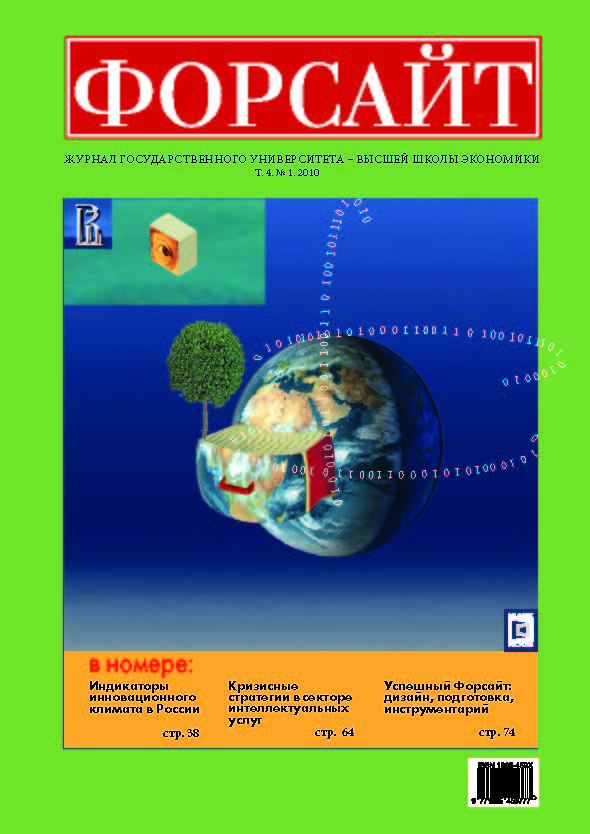Аннотация
Лицам, ответственным за создание базы компетенций, необходимых для будущего экономического развития, требуется более четкое понимание эффектов, производимых радикальными технологическими изменениями. В долгосрочной перспективе также изменения могут опровергнуть многие прогнозы, основанные на стандартных подходах и методах моделирования трендов занятости. В статье рассматриваются некоторые подходы к изучению ключевых новых технологий, а также оценивается полезность применения таких известных идей, используемых исследованиях инноваций, как: анализ диффузии и жизненного цикла отрасли, проработка парадигм и траекторий технологического развития. Особые методологические трудности возникают в сфере нанотехнологий, что обусловлено и ее зачаточным состоянием, и пересечением на наноуровне разных областей знания, и масштабами и скоростью эволюции. Автор оценивает степень достоверности существующих прогнозов занятости и компетенций в наноиндустрии, а также более общих приложений нанотехнологий в промышленности, и предлагает пути повышения их надежности и более качественного информационного обеспечения политики.
Литература
Abicht L. (2009) Qualification Structure and Demand for Further Education of German Nanotechnology Companies/W. Luther and G. Bachmann (eds). Nano.DE-Report 2009: Status Quo of Nanotechnology in Germany. Bonn, Germany: Federal Ministry of Education and Research, Department of Nanomaterials, New Materials.
Barker B. (1990) Engineering Ceramics and High-temperature Superconductivity: Two Case Studies in the Innovation and Diffusion of New Materials. DPhil thesis. Manchester: PREST.
Bell D. (1964) Twelve Modes of Prediction -a Preliminary Sorting of Approaches in the Social Sciences. V. 93. Daedalus.
Beniger J. (1986) The Control Revolution: Technological and Economic Origins of the Information Society. Harvard University Press.
CEPIS (2006) Thinking Ahead on e-Skills for the ICT Industry in Europe. Brussels: Council of European Professional Informatics Societies, 2006. URL: http://ec.europa.eu/enterprise/sectors/ict/files/thinkingaheadone-skillsineuropereport_en.pdf.
Cohendet P., Ledoux M.J., Zuskovitch E. (1991) The Evolution of New Materials: A New Dynamic for Growth in Technology and Productivity: The Challenge for Economic Policy. Paris: OECD.
David P. A. (1991) Computer and Dynamo: the Modern Productivity Paradox in a Not-Too-Distant Mirror in Technology and Productivity. Paris: OECD.
Freeman C. (1974) The Economics of Industrial Innovation. Penguin, Harmondsworth.
Freeman C., Louca F. (2002) As Time Goes By: From the Industrial Revolutions to the Information Revolution. Oxford: Oxford University Press.
Freeman C., Perez C. (1988) Structural crises of adjustment, business cycles and investment behaviour/G. Dosi, C. Freeman, R. Nelson, G. Silverberg, G. Soete (eds.)//Technical Change and Economic Theory. London: Pinter. P. 38-66.
Green L., Jones B., Miles I. (2008) Skills for Innovation/INNOGRIPS Mini Study 03, Global Review of Innovation Intelligence and Policy Studies. URL: http://grips.proinno-europe.eu/knowledge_base/view/222/grips-mini-study-on-skills-for-innovation/.
Harper T. (2008) From Micro to Nanoelectronics: Disruption, Convergence or Evolution? Emerging Markets Semiconductor Applications Technology Symposium. Singapore: Suntec. URL: http://www.semiconsingapore.org/ProgrammesandEvents/cms/groups/public/documents/web_content/ctr_023570.pdf.
Hendry C. (1999) New Technology Industries. Skills Task Force Research Paper. London: DfEE.
Jorgenson D.W., Ho M.S., Stiroh K. J. (2008) A Retrospective Look at the U.S. Productivity Growth Resurgence Journal of Economic Perspectives. V. 22. № 1. P. 3-24.
Kaounides L.C. (1995) Advanced Materials. London: Pearson Professional.
Miles I. (1996) Information Technology & Information Society: Options for the Future. London: Economic & Social Research Council, PICT Policy Research Papers, 1988, № 2. Revised/reprinted as The Information Society: Competing Perspectives on the Social and Economic Implications of Information and Communications Technologies/W. Dutton (ed.). Information and Communications Technologies: Visions and Realities. Oxford: Oxford University Press.
NIA Forecast of Emerging Technologies (2007). London: Nanotechnology Industries Association. URL: http://www.nanotechia.org/lib/tmp/cmsfiles/File/NIA_TechnologyForecast_June2007.pdf.
Naisbitt J. (1982) Megatrends. Warner Books.
Roco M.C. (2007) National Nanotechnology Initiative -Past, Present, Future/Goddard W., Brenner D., Lyshevski S., Iafrate G. Handbook of Nanoscience, Engineering and Technology (2nd ed.). CRC Press (Taylor and Francis).
Rogers E.M. (1995) Diffusion of innovations (4th ed.). New York: Free Press.
Tether B., Mina A., Consoli D., Gagliardi D. (2005) A Literature Review on Skills and Innovation. How Does Successful Innovation Impact on the Demand for Skills and How Do Skills Drive Innovation?/CRIC report for the Department of Trade and Industry. London: Department of Trade and Industry.
The Handbook of Technology Foresight (2008)/L. Georghiou, Cassingena Harper J., M. Keenan, I. Miles, R. Popper (eds.). UK: Cheltenham and Northampton; USA: MA, Edward Elgar.
Utterback J.M. (1996) Mastering the Dynamics of Innovation. Harvard Business School Press.
Vanston J., Elliot L. (2003) Nanotechnology: A Technology Forecast. Technology Futures Inc. for Texas State Technology College, Waco, Texas.
Vernon R. (1966) International Investment and International Trade in the Product Cycle//Quarterty Journal of Economics. V. 80. P. 190-207.
Von Tunzelmann G.N. (1978) Steam Power and British Industrialization to 1860. Oxford: Clarendon Press.

Это произведение доступно по лицензии Creative Commons «Attribution» («Атрибуция») 4.0 Всемирная.

